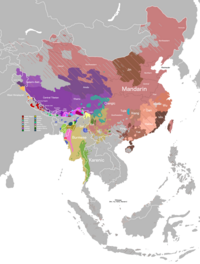Shixing language
Appearance
| Shixing | |
|---|---|
| Shuhi | |
| Native to | China |
Native speakers | 1,800 (2000)[1] |
| Language codes | |
| ISO 639-3 | sxg |
| Glottolog | shix1238 |
| ELP | Shixing |
Shixing, also rendered Shuhi, is a Qiangic language of Sichuan, China. Two-thirds of its speakers are monolingual.
Shixing is also known by its Tibetan name Xumi (旭米 Xùmǐ); it is spoken by about 1800 people living by the Shuiluo River 水洛 in Shuiluo Township 水洛乡, Mili Tibetan Autonomous County.[2]
Katia Chirkova reports two varieties.[3]
- Upper Xumi (autonym: ʂuhĩ)
- Lower Xumi (autonym: ʃʉhẽ)
Phonology
Consonants
Xumi features a very unusual phonemic contrast between voiceless /ʎ̥/ and voiced /ʎ/ alveolo-palatal lateral approximants and voiceless and voiced glottal fricatives.[4][5]
| Labial | Alveolar | Postalveolar | Velar | Uvular | Glottal | |||||
|---|---|---|---|---|---|---|---|---|---|---|
| plain | sibilant | Palato- alveolar |
Retroflex | Alveolo- palatal | ||||||
| Nasal | voiceless | m̥ | n̥ | ɲ̊2 | ŋ̊2 | |||||
| voiced | m | n | ɲ | ŋ | ||||||
| Plosive/ | aspirated | pʰ | tʰ | tsʰ | tʃʰ2 | ʈʂʰ | tɕʰ | kʰ | qʰ | |
| plain | p | t | ts | tʃ2 | ʈʂ | tɕ | k | q | ||
| voiced | b | d | dz | dʒ2 | ɖʐ | dʑ | ɡ | ɢ2 | ||
| Fricative | voiceless | s | ʃ2 | ʂ1 | ɕ | x | χ1 | h | ||
| voiced | z | ʒ2 | ʐ1 | ʑ2 | ɣ2 | ʁ | ɦ | |||
| Lateral | voiceless | l̥ | ʎ̥ | |||||||
| voiced | l | ʎ | ||||||||
| Approximant | ɹ | j | w | |||||||
- Only in Upper Xumi
- Only in Lower Xumi
Vowels

Oral
- The close and close-mid series are the same in both varieties: /i, ʉ, u, e, o/. The difference lies in the open-mid and open series; in Upper Xumi, these are /ɛ, ɐ, ɔ, a/, whereas in Lower Xumi, they are /ɛ, ɐ, ɑ/.[8][9]
- At least in Lower Xumi /ʉ/, is phonetically close-mid [ɵ].[10]
- /ɐ/ is closer in Upper Xumi [ɜ]; in addition, the open central vowel /a/ is phonetically near-open [ɐ]. For this reason, they may be transcribed with ⟨ɜ⟩ and ⟨ɐ⟩, respectively.[11]
- The Lower Xumi /o/ and /ɑ/ generally correspond to Upper Xumi /u/ and /ɔ/, respectively. /ɑ/ is near-open near-back [ɑ̽] and thus similar to the Upper Xumi /a/, but more back.[10][11]
Nasal
- Upper Xumi has the following nasal vowels: /ĩ, ũ, ɛ̃, ɔ̃, ɐ̃/, as well as the marginal /ɘ̃/, which occurs only in the word [LPmɘ̃da][clarification needed] 'on the roof / upstairs'.[8]
- Lower Xumi has the following nasal vowels: /ĩ, õ, ɛ̃, ɐ̃, ɑ̃/, as well as the marginal /ə̃/, which occurs only in the word [LPmə̃dɐ ᴿʁo][clarification needed] 'on the roof / upstairs'.[9] /ẽ, õ, ɐ̃, ɑ̃/ generally correspond to Upper Xumi /ĩ, ũ, ɛ̃, ɔ̃/, respectively.[11]
References
- ^ Shixing at Ethnologue (18th ed., 2015) (subscription required)
- ^ Chirkova & Chen (2013), p. 363.
- ^ Chirkova & Chen (2013), p. 364.
- ^ Chirkova & Chen (2013), pp. 365, 367–368.
- ^ Chirkova, Chen & Kocjančič Antolík (2013), pp. 382–383.
- ^ Chirkova, Chen & Kocjančič Antolík (2013), p. 382.
- ^ Chirkova & Chen (2013), p. 365.
- ^ a b Chirkova, Chen & Kocjančič Antolík (2013), pp. 388–389.
- ^ a b Chirkova & Chen (2013), pp. 369–370.
- ^ a b Chirkova & Chen (2013), p. 369.
- ^ a b c Chirkova, Chen & Kocjančič Antolík (2013), p. 389.
Bibliography
- Chirkova, Katia; Chen, Yiya (2013), "Xumi, Part 1: Lower Xumi, the Variety of the Lower and Middle Reaches of the Shuiluo River", Journal of the International Phonetic Association, 43 (3): 363–379, doi:10.1017/S0025100313000157
- Chirkova, Katia; Chen, Yiya; Kocjančič Antolík, Tanja (2013), "Xumi, Part 2: Upper Xumi, the Variety of the Upper Reaches of the Shuiluo River", Journal of the International Phonetic Association, 43 (3): 381–396, doi:10.1017/S0025100313000169
- Sun Hongkai [孙宏开]. 2014. A study of Shixing [Shixingyu yanjiu 史兴语研究]. Beijing: Minzu University Press.

